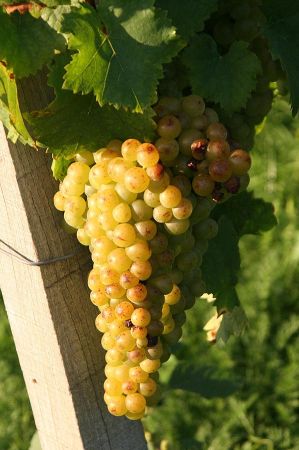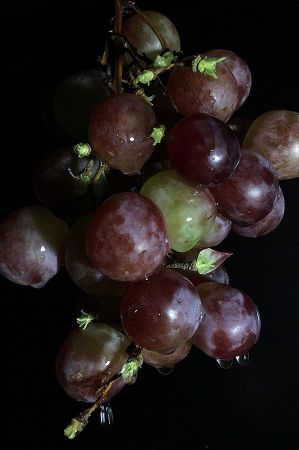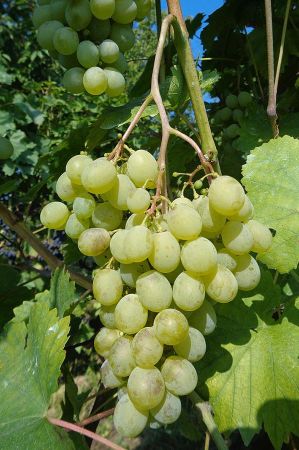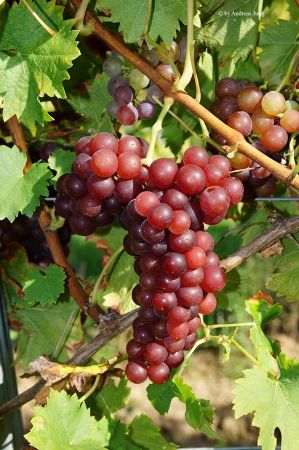Muskateller – a pleasure as a grape
- Written by Portal Editor
You probably don't necessarily have to be a wine drinker to enjoy wine as a grape. Whatever the reason, there are things that are not so easy or even impossible to explain.
At least that's how I feel, I'm not a wine drinker, but I love the taste of the Muscat grapes.
Muscat was already known to the Egyptians 3000 years ago
 The Muscat is without a doubt one of the oldest types of white wine in the world, of which there are a large number of variations; over two hundred representatives of the Muscat family are currently known. According to one of the numerous literature references, the variety is said to have existed as early as 3000 BC. It may have been used by the Egyptians and in what is now Iran. However, like many other varieties, the origin of the grape variety probably lies in Asia Minor, i.e. today's Turkey and Iran. Phoenician and Greek colonists spread Muscat throughout the eastern Mediterranean. Later, the Romans valued the Greek “passum” as a particularly fine wine and spread it throughout their territory.
The Muscat is without a doubt one of the oldest types of white wine in the world, of which there are a large number of variations; over two hundred representatives of the Muscat family are currently known. According to one of the numerous literature references, the variety is said to have existed as early as 3000 BC. It may have been used by the Egyptians and in what is now Iran. However, like many other varieties, the origin of the grape variety probably lies in Asia Minor, i.e. today's Turkey and Iran. Phoenician and Greek colonists spread Muscat throughout the eastern Mediterranean. Later, the Romans valued the Greek “passum” as a particularly fine wine and spread it throughout their territory.
Apparently Charlemagne (742-814) was already a great admirer of Muscat. The earliest concrete mention of the name Muscat dates back to 1230 to 1240 in the Liber de proprietatibus rerum - an encyclopedia by the scholastic Bartholomaeus Anglicus. Muskateller, in turn, comes from the Italian moscatello.
Venice played a special mediating role
 Muscat wine reached Central and Northern Europe through the intensification of long-distance trade in the 12th century. Venice played a special role as an intermediary between the Orient and the Occident and controlled several islands in the eastern Mediterranean where Muscat wine was grown. In the sources, Muscat is often called “Greek wine” or “Cyprus wine”. Southern wines spread as a trade commodity in Europe not only through long-distance trade, but also through pilgrimages and crusades. Emperor Barbarossa appreciated this wine, which is also mentioned in the Nibelungenlied. The light white wine is characterized by its fine fruity acidity and its typically intense, but not intrusive, nutmeg bouquet.
Muscat wine reached Central and Northern Europe through the intensification of long-distance trade in the 12th century. Venice played a special role as an intermediary between the Orient and the Occident and controlled several islands in the eastern Mediterranean where Muscat wine was grown. In the sources, Muscat is often called “Greek wine” or “Cyprus wine”. Southern wines spread as a trade commodity in Europe not only through long-distance trade, but also through pilgrimages and crusades. Emperor Barbarossa appreciated this wine, which is also mentioned in the Nibelungenlied. The light white wine is characterized by its fine fruity acidity and its typically intense, but not intrusive, nutmeg bouquet.
 The approximately 300 synonyms - many of the names are numerous varieties with a wide variety of berry colors - testify to the ancient age and worldwide distribution of the vine. The most common variety of the grape variety is Muscat Blanc with white or yellow berries, which is also known in German-speaking countries as “Gelber Muskateller” or simply “Muscateller”. Some grape varieties have “Muscat” in their name even though they are not related to the grape variety, e.g. Grüner Muskateller (Veltliner) or Muscat-Ottonel.
The approximately 300 synonyms - many of the names are numerous varieties with a wide variety of berry colors - testify to the ancient age and worldwide distribution of the vine. The most common variety of the grape variety is Muscat Blanc with white or yellow berries, which is also known in German-speaking countries as “Gelber Muskateller” or simply “Muscateller”. Some grape varieties have “Muscat” in their name even though they are not related to the grape variety, e.g. Grüner Muskateller (Veltliner) or Muscat-Ottonel.
Relatively small cultivated area in Germany
 In Germany, the Muscat vine is grown on around 500 hectares of planted vineyards, mainly in the Palatinate, Baden and Württemberg. The medium-late ripening vine prefers good, warmer locations on deep soils.
In Germany, the Muscat vine is grown on around 500 hectares of planted vineyards, mainly in the Palatinate, Baden and Württemberg. The medium-late ripening vine prefers good, warmer locations on deep soils.
The bouquet has a typically pronounced, spicy nutmeg tone in all expansion variants. It is used for both dry and sweet wines and sparkling wines. In this country, the low-acid wine, which appears fresh and yellow-green in the glass, is usually made dry. The wines are ideal as blended wines.
Dry Muscat goes well with spicy poultry. As a noble sweet variant, it is often drunk as an aperitif or with desserts.
Today, Muscat is the collective term for Muscat varieties of the grape and their varieties, crosses or new varieties with Muscat involvement and unrelated grape varieties. There are muscat varieties with berries in various shades of white, yellow, gray, green, pink, red, brown, violet, blue and black.
 The earliest concrete mention of the name Muscat dates back to 1230 to 1240 in the Liber de proprietatibus rerum - an encyclopedia by the scholastic Bartholomaeus Anglicus.
The earliest concrete mention of the name Muscat dates back to 1230 to 1240 in the Liber de proprietatibus rerum - an encyclopedia by the scholastic Bartholomaeus Anglicus.
Some variants have worldwide distribution and significance.
White wine types:
- Yellow Muscat, French muscat blanc à petits grains
- Red Muscat
Table grape varieties:
- Muscat de Hamburg
- Muscat d’Alexandrie (Muscat of Alexandria)
Please read as well:
